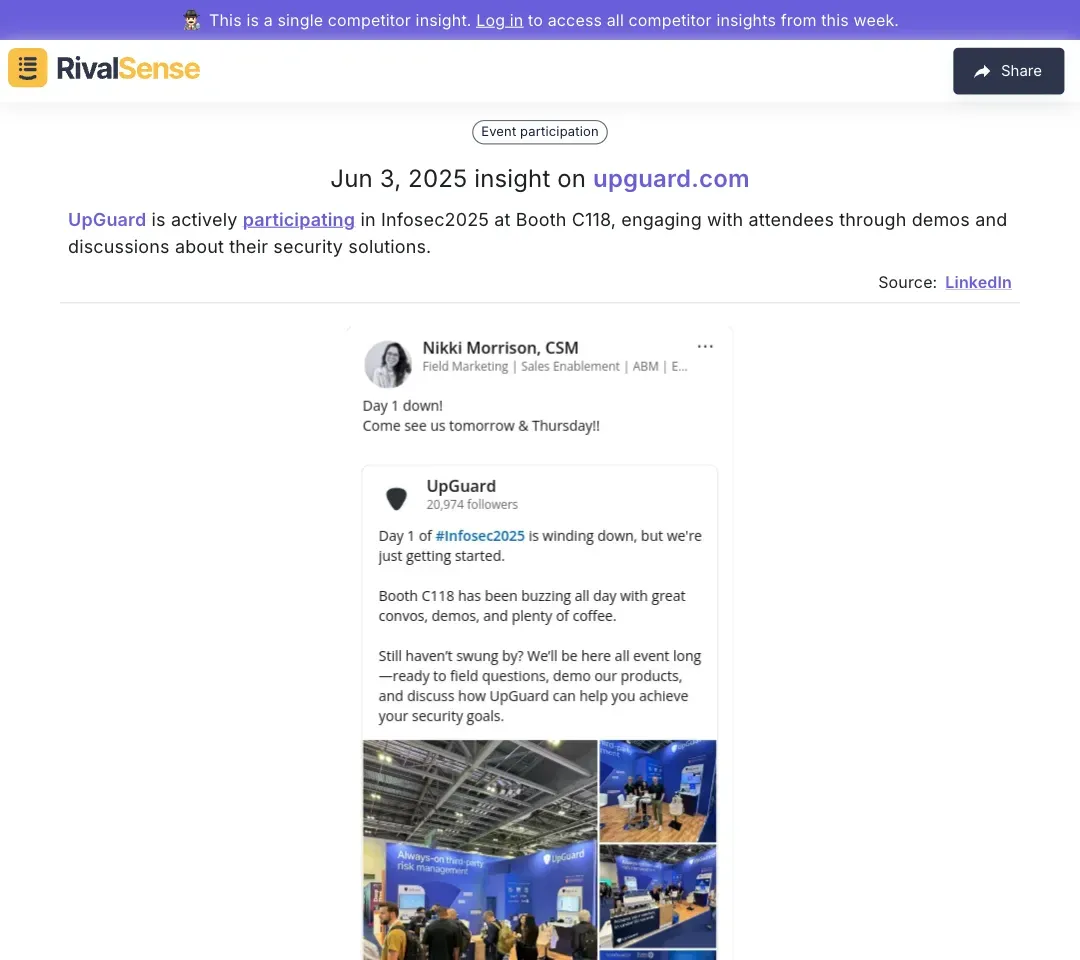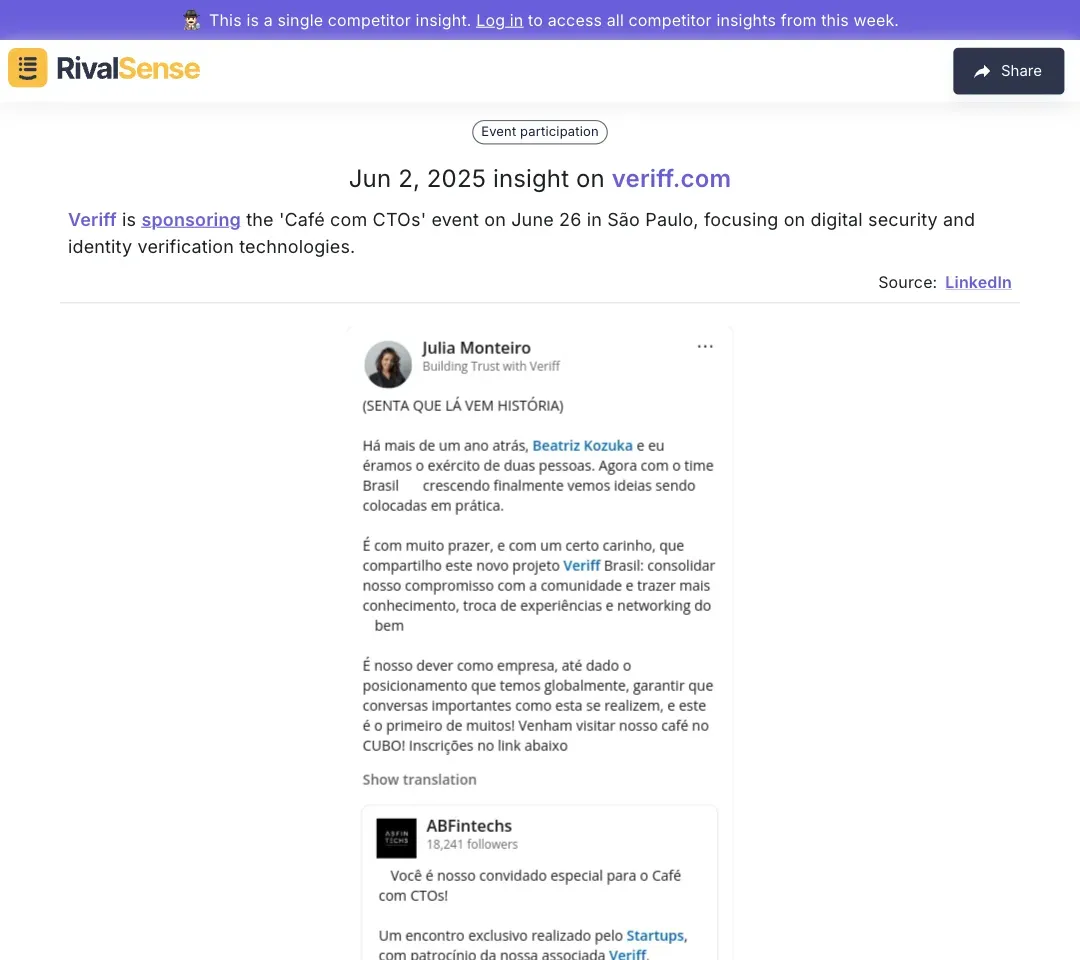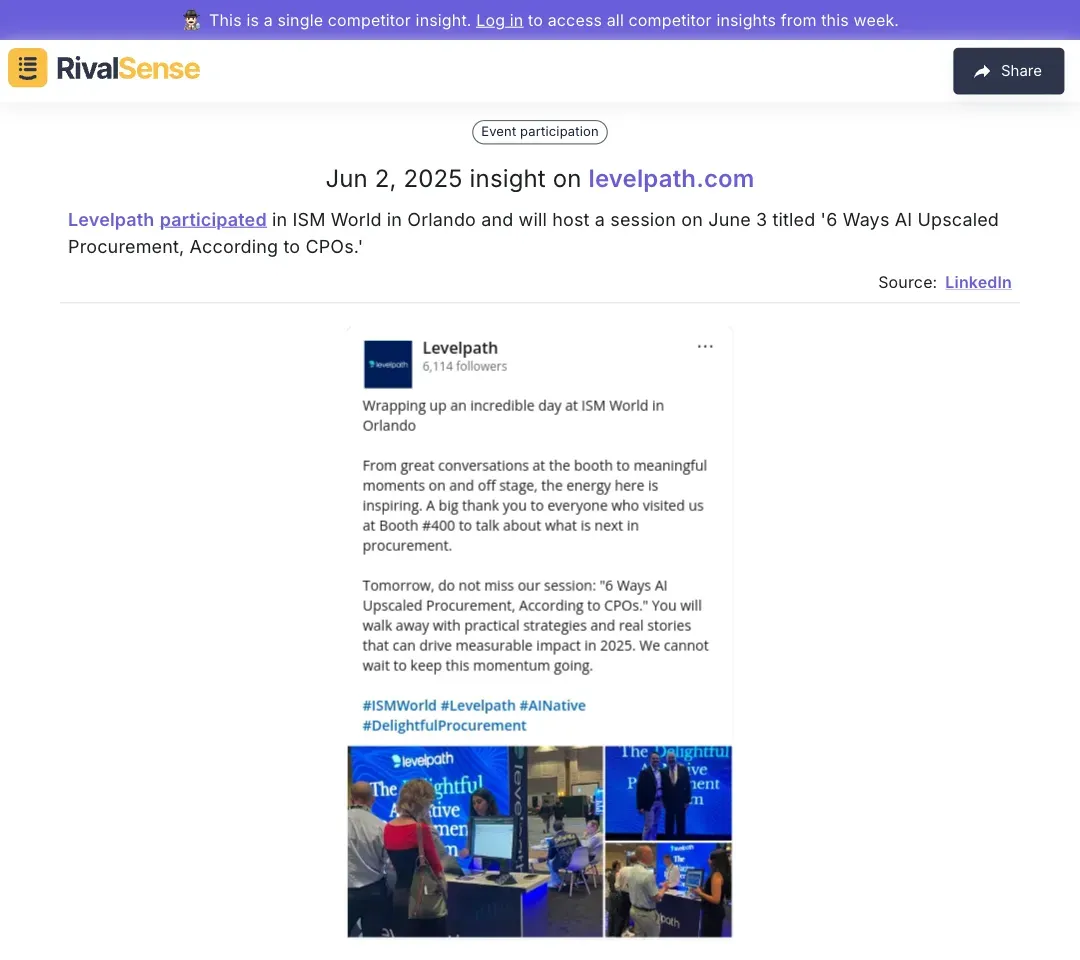Decoding Competitor Event Moves: Boost Your Segmentation Strategy
Understanding competitors' event strategies reveals invaluable insights about their market priorities and audience targeting. By analyzing where they exhibit, sponsor, or speak, you gain clarity on their strategic focus areas and resource allocation. This intelligence helps refine your segmentation approach and identify market gaps before competitors capitalize on them.
For instance, repeated presence at AI conferences signals heavy investment in artificial intelligence capabilities—knowledge that should inform your own roadmap. Beyond surface-level observations, event patterns also expose how rivals position their brand and cultivate industry influence. High-profile engagements often indicate thought leadership ambitions, while niche events suggest specialized audience targeting.
🚀 Practical starting steps:
- Identify top competitors and catalog their past event engagements
- Monitor event announcements for competitor participation clues
- Analyze event themes to infer strategic priorities
- Compare against your event footprint to spot opportunities
- Adjust strategy based on insights—target underserved events
Automated tools like RivalSense streamline this process by delivering real-time updates on competitor movements directly to your inbox.
Types of Competitor Event Participation to Monitor
Different participation formats reveal distinct aspects of competitor strategy. Booth exhibitions demonstrate customer engagement tactics, while sponsorships reflect marketing budget priorities. Each format provides unique intelligence for sharpening your segmentation approach.
Key participation types to track:
| Type | Strategic Insight | Actionable Tip |
|---|---|---|
| Active Booth Participation | Product focus & demo priorities | Note engagement tactics (e.g., live demos vs. presentations) |
| Event Sponsorships | Target audience & market priorities | Track sponsorship tier and audience alignment |
| Thought Leadership Sessions | Expertise positioning & trend focus | Analyze session topics for strategic themes |
🔍 Real RivalSense Insight:

UpGuard is actively participating in Infosec2025 at Booth C118, engaging with attendees through demos and discussions about their security solutions.
Why valuable: Booth activity reveals how competitors position products live—critical for benchmarking your own exhibition strategy and identifying engagement gaps.
Analyzing Competitor Engagement Strategies
Beyond mere attendance, how competitors engage at events provides deeper strategic intelligence. Their interaction methods, sponsorship levels, and session formats all contribute to understanding their market approach. This analysis helps identify where you can differentiate your event presence.
Key engagement elements to evaluate:
-
Interactive Demos/Discussions
Competitors using hands-on experiences typically target high-consideration buyers. Note which features they highlight and audience reactions. -
Sponsorship Hierarchy
Main stage sponsors target broad awareness, while workshop sponsors seek niche engagement. Track patterns across multiple events. -
Session Content Focus
Presentation topics reveal emerging priorities. Technical deep-dives signal product maturity, while visionary talks indicate market shaping.
✅ Actionable checklist:
- [ ] Record competitor booth traffic patterns
- [ ] Catalog session topics and speaker seniority
- [ ] Compare sponsorship levels year-over-year
- [ ] Note attendee engagement methods (QR codes, lead cards, etc.)
🔍 Real RivalSense Insight:

Veriff is sponsoring the 'Café com CTOs' event on June 26 in São Paulo, focusing on digital security and identity verification technologies.
Why valuable: Regional sponsorships signal geographic expansion priorities—essential for anticipating new market entries and adjusting your localization strategy.
Leveraging Insights for Better Market Segmentation
Competitor event data illuminates underserved segments and emerging opportunities. By mapping their participation patterns against audience demographics, you can identify white spaces in the market. This intelligence enables smarter resource allocation and differentiated positioning.
Start by categorizing competitor events by:
- Industry vertical focus
- Attendee seniority levels
- Geographic concentration
- Event size/niche status
Discover gaps where competitors underinvest—perhaps mid-market segments or specific regions. Then align your event strategy to dominate these openings. For example, if rivals focus exclusively on enterprise conferences, target growth-stage business events.
🎯 Segmentation refinement steps:
- Overlay competitor event maps with your ideal customer profile
- Identify 2-3 underserved segments with high potential
- Develop tailored messaging for each gap opportunity
- Test through smaller events before scaling
- Monitor competitor reactions to your moves
Case Studies: Strategic Lessons from Real Event Moves
Concrete examples demonstrate how event intelligence drives business outcomes. These real-world cases show the tangible impact of decoding competitor participation patterns.
Booth Strategy Win
A SaaS security vendor noticed competitors avoiding hands-on demo booths at regional events. By implementing interactive kiosks at these undervalued conferences, they captured 35% more qualified leads versus industry averages.
Sponsorship Targeting Success
After identifying rivals' neglect of LATAM fintech events, a compliance platform became lead sponsor at Brazil's FinanceTech Week. This resulted in 50+ enterprise meetings with their exact ICP attendees.
Thought Leadership Impact
🔍 Real RivalSense Insight:

Levelpath participated in ISM World in Orlando and will host a session on June 3 titled '6 Ways AI Upscaled Procurement, According to CPOs.'
Why valuable: Session topics reveal where competitors build authority—helping you counter-position or address adjacent pain points they ignore.
Actionable Steps to Implement Competitor Insights
Converting observations into strategy requires systematic execution. Follow this battle-tested approach to operationalize event intelligence:
Phase 1: Tracking Setup
- Use specialized tools like RivalSense for automated competitor monitoring
- Create event dashboards tracking: participation frequency, formats, and locations
- Set alerts for competitor speaker announcements or sponsorship reveals
Phase 2: Strategy Development
- Conduct SWOT analysis on competitor event weaknesses
- Allocate budget to exploit gaps (e.g., underserved regions/verticals)
- Design differentiated engagement formats they can't easily replicate
Phase 3: Execution & Measurement
- Benchmark against competitors: lead volume, meeting quality, social mentions
- Track post-event pipeline velocity from targeted segments
- Calculate share-of-voice compared to key rivals
📋 Implementation checklist:
- [ ] Establish automated competitor tracking system
- [ ] Map competitor event footprint quarterly
- [ ] Identify 1-2 strategic gaps to exploit
- [ ] Develop unique engagement hooks for target segments
- [ ] Measure post-event metrics against competitors
Ready to decode competitor moves?
Don't let valuable event intelligence slip through the cracks. Try RivalSense free to automatically track competitor activities—from product launches to event strategies—and get your first competitor report today. Gain the insights needed to outmaneuver rivals and own your market segments.
📚 Read more
👉 Game Theory in Competitor Analysis: Anticipate Moves and Strategize Like a Pro
👉 Real World Competitor Analysis Walkthrough
👉 Decoding WTW's Strategic Shift: From ESG to Sustainability Focus
👉 Decoding Competitor Moves: Guesty's Expansion and Strategic Hiring
👉 Decoding Competitor Moves: How Zip's 2025 Procurement Strategy Can Inform Your AI Readiness
